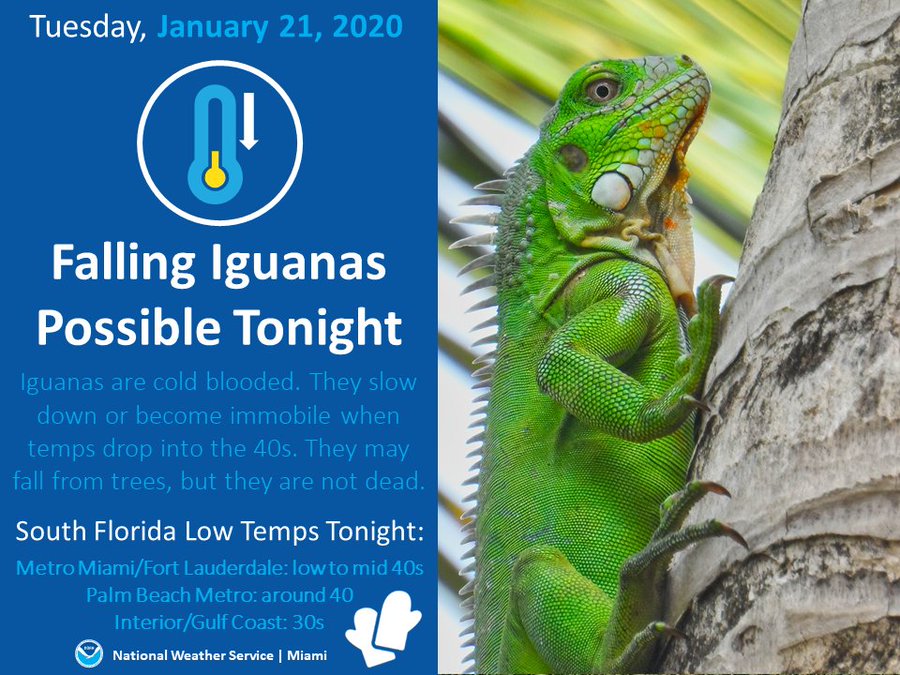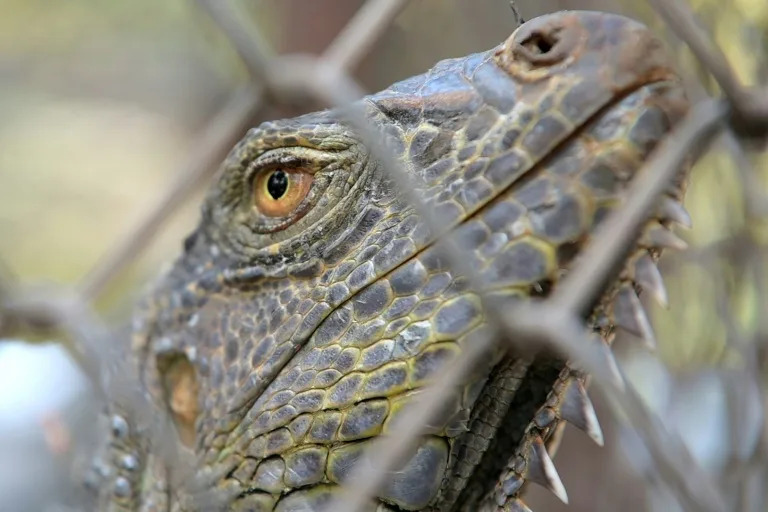Iguanas could fall from the trees in Florida

By Allison Chinchar, CNN Meteorologist
Cold-stunned iguanas expected to fall from Florida trees

As the coldest air of the season spreads across the Eastern US, even some southern states are feeling the chill.
From Louisiana to the Carolinas, even down through Florida, temperatures are averaging 10 to 15 degrees below normal.
Freeze warnings and hard freeze warnings are in effect across Florida and Georgia through Wednesday morning.
Tuesday afternoon, the National Weather Service in Miami issued a rare forecast regarding cold temperatures but it was for iguanas. Yes, you read that correctly.
I - guan - as
"Don't be surprised if you see iguanas falling from the trees tonight," tweeted the Miami National Weather Service office.
The concern for people in South Florida is that these iguanas often sleep in trees, so when their bodies go dormant, they appear to fall from the sky onto streets, cars, pools, or even people walking around. And since iguanas are large -- adult males can reach 5 feet in length, and weigh up to 20 pounds -- this can be dangerous if one lands on top of you.
The invasive species can't handle cold temperatures very well because they are cold-blooded. In general, iguanas begin to get sluggish or lethargic once the temperature drops below 50 degrees Fahrenheit.
Once the temperature drops below 45 degrees Fahrenheit the iguanas go into a dormant or cold-stunned state. They appear to be dead, but they are not. They remain breathing with critical body functions still operating.
It is their body's way of protecting them until the temperature warms up back up above 50 degrees.
If those temperatures remain in the 40s for periods over eight hours, a significant number of those iguanas will die, especially the smaller ones.
"The temperature threshold for when iguanas begin to go into a dormant state depends greatly on the size of the iguana," explains Ron Magill, communications director for Zoo Miami. "Generally speaking, the larger the iguana, the more cold it can tolerate for longer periods."
He also demonstrates how even though extended periods of air temperatures in the 40s could lead to the demise of some iguanas. Many iguanas in South Florida have adapted to going deep into burrows where they stay insulated from the cold. They tend to also live close to large bodies of water, which tend to be warmer than the air temperatures, which help them survive short cold snaps.
Not everyone is concerned about the well-being of these iguanas, though. They are considered an invasive species, so some people are looking forward to an opportunity to rid their yards of these reptiles.
"I do know that there are several iguana hunters that are looking forward to this upcoming cold front as it will certainly facilitate them removing these invasive reptiles from the South Florida environment as they will not be able to run away!" Magill told CNN.
‘They’re not dead’: Falling iguana alert in Florida amid cold snap
January 22, 2020 By Agence France-Presse

Green iguanas are considered a nuisance in Florida, where they are blamed for causing considerable damage to everything from seawalls to sidewalks — not to mention menacing endangered butterflies and snails.
But the invasive species may have met their match in an unusual cold snap which sent thermometers plummeting in Florida, rendering the cold-blooded reptiles paralyzed.
“This isn’t something we usually forecast, but don’t be surprised if you see Iguanas falling from the trees tonight as lows drop into the 30s and 40s. Brrrr,” tweeted the National Weather Service in Miami. That is between -1 and 4 degrees Celsius.
Such conditions are unusual in the normally balmy US state, where winter temperatures typically don’t fall below 65 degrees Fahrenheit (18 degrees Celsius) or so.
Many people don’t have the proper heating at home or clothing to cope with the freezing temperatures — something also true of the state’s animals.
An infographic attached to the tweet added that although the cold-stunned creatures may appear to have met their end, “they are not dead.”
Last January, another cold front saw a similar deluge of frozen iguanas, with members of the public sharing pictures on social media, and bringing them home to defrost — something authorities discourage since the wild animals may attack humans once revived.
The species isn’t native to Florida but was brought in by travelers from Central and South America in the 1960s.
The Florida Fish and Wildlife Conservation Commission has declared open season on the iguanas, writing on its website that it encourages homeowners to remove them from their property, while killing them on public lands is permissible without a license.
Falling iguanas in the forecast: National Weather Service warns Floridians ice cold reptiles will tumble from trees
By STEPHANIE SIGAFOOS
THE MORNING CALL
JAN 22, 2020 | 6:16 AM

This isn’t something we usually forecast, but don’t be surprised if you see
Iguanas falling from the trees tonight," the National Weather Service in Miami
tweeted on Tuesday. (Martin Meissner/AP)
Jan 21 - This isn't something we usually forecast, but don't be surprised if you see Iguanas falling from the trees tonight as lows drop into the 30s and 40s. Brrrr! #flwx #miami pic.twitter.com/rsbzNMgO01
— NWS Miami (@NWSMiami) January 21, 2020
Twitter reacted appropriately. One reply on the post asked, “So, is this an advisory, a watch, or a warning?” Another wondered, “Do iguana showers show up on Doppler (radar)?”
Even the New York Times got in on the fun with its take on the “Night of the Falling Iguanas. An Odd Forecast for South Florida.”
Temperatures in Miami had dropped to 42 degrees by Wednesday morning, with wind chills in the mid 30s. The cold is enough to stun the iguanas, which typically climb trees at night to roost, the communications director for Zoo Miami told the Times in 2018. When the temperature drops below 50, the reptiles enter a lethargic state and loosen their grip, commencing free fall.
Iguana accumulation of a trace recorded by Miami https://t.co/w0ZquRWEBl— Tomer Burg (@burgwx) January 22, 2020
‘They’re a Menace’
Floridians are no fans of iguanas. The bright green herbivorous lizards had their time in the spotlight last year when the Miami Herald documented the explosion of the “in-your-face invasive species” in South Florida.
Iguanas had been spotted in the wild across much of the state, the story said, pooping in pools, grazing in gardens, and shorting out power lines. They became such a problem that wildlife officials encouraged residents to “humanely kill green iguanas on their own property whenever possible.”
The edict sparked backlash from animal rights groups, and many iguanas were seemingly spared. The result, according to a story in The Washington Post, was the continued “erosion and degradation of infrastructure such as water control structures, canal banks, sea walls and building foundations."
Scientists say iguanas will eventually die off if a serious cold snap sticks around more than 72 hours, but that rarely happens in South Florida. In fact, temperatures were expected to bounce back into the 60s and 70s for the remainder of the week.

